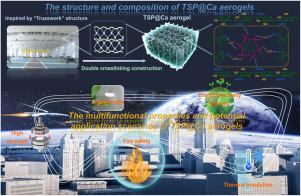桁架启发超高强度,防火,隔热双交联木气凝胶
IF 14.3
1区 材料科学
Q1 MATERIALS SCIENCE, MULTIDISCIPLINARY
引用次数: 0
摘要
生物基木质气凝胶是替代传统石化基保温材料的最有前途的材料之一。然而,生物基木材气凝胶的可燃性和较差的机械强度限制了其在新兴领域的应用。受桁架支撑系统的启发,本研究通过双氢离子键策略制备了一种多功能生物基交联木气凝胶(TSP@Ca),该策略涉及氧化木纤维素框架、海藻酸钠、植酸(PA)和Ca2+。有限元模拟和力学分析表明,氧化木模板中形成的类似桁架框架的多点支撑结构显著提高了TSP@Ca气凝胶的强度(9.99 MPa),相对于氧化去木素化木材(TODW)的强度提高了154.84%。TSP@Ca3气凝胶的极限氧指数高达43.3%,灭火后可立即灭火。PA和Ca2+的引入促进了TSP@Ca气凝胶的脱水、交联和炭化,而产生的含磷自由基在气相中起抑制作用。因此,TSP@Ca气凝胶的放热率峰值比TODW低80.66%,具有较好的防火安全性。得益于复杂的导热路径和增强的界面阻力,TSP@Ca的导热系数比TODW低46.4%。所制得的气凝胶集超高机械强度、优异耐火性能和保温性能于一体,符合“绿色”发展目标,在建筑、轨道交通、新能源等领域具有广阔的应用潜力。本文章由计算机程序翻译,如有差异,请以英文原文为准。

Truss-inspired ultra-high strength, fire-safe, and thermal insulating double-crosslinked wood aerogels
Bio-based wood aerogel is one of the most promising materials to replace traditional petrochemical-based insulation materials. However, the flammability and poor mechanical strength of bio-based wood aerogels limit their applications in emerging fields. Inspired by a truss-supporting system, this study prepared a multifunctional bio-based cross-linked wood aerogel (TSP@Ca) by a dual hydrogen-ionic bonding strategy involving an oxidized wood cellulose framework, sodium alginate, phytic acid (PA), and Ca2+. Finite element simulation and mechanical analysis indicated that the multi-point support structure, resembling a truss framework, formed in the oxidized wood template significantly improved the strength of TSP@Ca aerogel (9.99 MPa), with a 154.84% enhancement relative to that of oxidized delignified wood (TODW). The limiting oxygen index of TSP@Ca3 aerogel was as high as 43.3%, and it can extinguish immediately when the fire was removed. The introduction of PA and Ca2+ promoted the dehydration, cross-linking, and charring of TSP@Ca aerogel, while the produced phosphorus-containing free radicals played an inhibitory role in the gas phase. Therefore, the peak of heat release rate of TSP@Ca aerogel was 80.66% lower than that of TODW, showing excellent fire safety. Benefiting from the complex heat conduction path and enhanced interface resistance, the thermal conductivity of TSP@Ca was 46.4% lower than that of TODW. The resulting aerogel combines ultra-high mechanical strength, excellent fire resistance, and thermal insulation, aligning with “green” development goals and offering broad application potential in construction, rail transport, and new energy sectors.
求助全文
通过发布文献求助,成功后即可免费获取论文全文。
去求助
来源期刊

Journal of Materials Science & Technology
工程技术-材料科学:综合
CiteScore
20.00
自引率
11.00%
发文量
995
审稿时长
13 days
期刊介绍:
Journal of Materials Science & Technology strives to promote global collaboration in the field of materials science and technology. It primarily publishes original research papers, invited review articles, letters, research notes, and summaries of scientific achievements. The journal covers a wide range of materials science and technology topics, including metallic materials, inorganic nonmetallic materials, and composite materials.
 求助内容:
求助内容: 应助结果提醒方式:
应助结果提醒方式:


